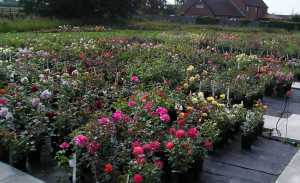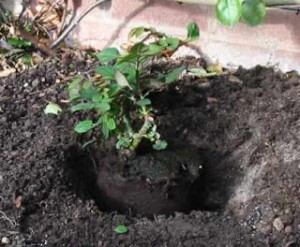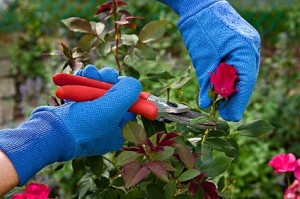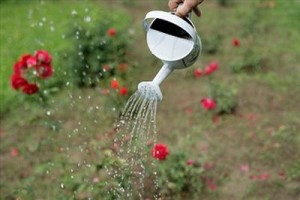General Rose Care
ROSE CARE STARTS WHEN YOU BUY YOUR ROSES!
 Visit a rose garden, study pictures or search the internet to acquaint yourself with the type of roses you want. Shrubs, climbers, species, and old garden roses can be incorporated into the landscape as part of a perennial border as mass plantings. Hybrid Teas, grandifloras, floribundas, polyanthas, miniatures or minifloras are often grown in separate beds and can be used for cut flowers.
Visit a rose garden, study pictures or search the internet to acquaint yourself with the type of roses you want. Shrubs, climbers, species, and old garden roses can be incorporated into the landscape as part of a perennial border as mass plantings. Hybrid Teas, grandifloras, floribundas, polyanthas, miniatures or minifloras are often grown in separate beds and can be used for cut flowers.
You may buy rose plants dormant (bare root) or potted. Dormant roses come without soil. When purchasing dormant roses specify #1 stock. The Minnesota Rose Society does not recommend buying roses in plastic bags or covered with wax. Dormant roses may be planted between April 10 and May 15. Avoid buying dormant roses that show growth for the growth has taken strength from the plant. Potted roses should show good growth and may be planted from May 15 throughout the growing season. Potted roses should be clean, healthy and have a minimum of 3 good canes.
Planting
 Choose a location that gets at least 6 hours of full sun and is away from large trees and shrubs that would compete with the roses for sun, food and water. A well drained sandy loam with a pH of 6.7-6.8 is best. Prepare the soil by incorporating humus (manure, compost, peat) into the soil well prior to planting. Let soil settle before planting. Soak dormant plants in water for several hours before planting. Cut off damaged canes, excess branches and weak growth. Cut back any damaged or very long roots to about 12 inches. Always protect the plant and roots from sun and wind prior to planting. Dig a hole large enough to spread out the roots in a natural shape. Make a cone shaped mound in hole and spread roots evenly down and over the mound. If you will use the Minnesota Tip Method of winter protection then plant the bud union at ground level. If using an alternate method of winter protection set the bud union 2-4 inches below ground level. Half fill the hole with soil and gently press soil into place with hands to eliminate air pockets. Fill the hole with water and let drain away. Fill the soil with the rest of the soil. Mound additional soil over the plant about 6-10 inches high; keep this wet for about 10 days or until new growth has started. When growth has started, carefully remove the soil mound. DO NOT fertilize new plants until after their first bloom.
Choose a location that gets at least 6 hours of full sun and is away from large trees and shrubs that would compete with the roses for sun, food and water. A well drained sandy loam with a pH of 6.7-6.8 is best. Prepare the soil by incorporating humus (manure, compost, peat) into the soil well prior to planting. Let soil settle before planting. Soak dormant plants in water for several hours before planting. Cut off damaged canes, excess branches and weak growth. Cut back any damaged or very long roots to about 12 inches. Always protect the plant and roots from sun and wind prior to planting. Dig a hole large enough to spread out the roots in a natural shape. Make a cone shaped mound in hole and spread roots evenly down and over the mound. If you will use the Minnesota Tip Method of winter protection then plant the bud union at ground level. If using an alternate method of winter protection set the bud union 2-4 inches below ground level. Half fill the hole with soil and gently press soil into place with hands to eliminate air pockets. Fill the hole with water and let drain away. Fill the soil with the rest of the soil. Mound additional soil over the plant about 6-10 inches high; keep this wet for about 10 days or until new growth has started. When growth has started, carefully remove the soil mound. DO NOT fertilize new plants until after their first bloom.
Your potted roses may be planted in much the same way. Dig a hole deep enough to accommodate the plant at the correct height as described above. Water the plant before removing from container. Be careful to keep the soil ball intact. Set plant in hole making sure that any roots coiled around soil ball are straightened out. Half fill hole with soil as above. Water well, let drain, then complete filling hole with soil. No need to mound. Water well.
Pruning
The purpose of pruning is to make plants grow, thrive and produce as you desire. Spring is the time for major pruning, while plants are semi-dormant. Always use sharp tools. Make a diagonal cut, 1/4 inch above and outward facing bud with the high side of the cut on the bud side. Prune so the center of the bush is open. Remove dead, diseased of damaged wood, any crowded, crossing or twiggy growth. Remove suckers from the bud union. To prevent damage from pith borers (cane borer) paint the cut ends of canes with white glue, nail polish, orange shellac or similar material. In pruning take it easy; once cut it cannot be replaced.
 Fertilizing depends on you and the amount of time, effort and funds you wish to spend. A handful of well balanced fertilizer worked in and around each bush in the spring and nothing thereafter all season will give you fair roses. Add another handful of the fertilizer 6 weeks later, and you will have better roses. But if you want the best roses you must do a few more things.
Fertilizing depends on you and the amount of time, effort and funds you wish to spend. A handful of well balanced fertilizer worked in and around each bush in the spring and nothing thereafter all season will give you fair roses. Add another handful of the fertilizer 6 weeks later, and you will have better roses. But if you want the best roses you must do a few more things.
If you can, put well rotted manure in your roses beds in the spring. If this is not available, use dehydrated manure, compost or peat. Bone meal or soy meal are also good to apply early in the growing season. Dig a small trench around each bush, apply and recover with soil. Because manures are slow acting and mainly for soil conditioning add of a handful of complete fertilizer in early May, June, July and August around each bush and work into the top 2 inches. In between monthly feedings extra “treats” such as fish emulsion, liquid manure or liquid fertilizer may be given. Give about 2 quarts per bush. Foliar feeding (used as a spray on leaves) may be given as a quick pick me up. To prevent root burn water your roses well before the application of any fertilizer but particularly before application of water soluble fertilizers. Do not apply any nitrogen containing fertilizers after August 15th.
Watering
 After planting your roses properly, the most important thing you can do is to water them. Fertilizing is necessary, but watering is essential, and often most neglected step to growing better roses. Do not count on rain alone to water your roses. Roses need more than the average rainfall. Get an early start on your watering. As soon as you uncover your roses begin watering and continue until they are protected for winter and the ground is frozen. Make sure your roses get at least 1inch per week, more if the weather is hot, dry and windy, even more if you have a sandy soil.
After planting your roses properly, the most important thing you can do is to water them. Fertilizing is necessary, but watering is essential, and often most neglected step to growing better roses. Do not count on rain alone to water your roses. Roses need more than the average rainfall. Get an early start on your watering. As soon as you uncover your roses begin watering and continue until they are protected for winter and the ground is frozen. Make sure your roses get at least 1inch per week, more if the weather is hot, dry and windy, even more if you have a sandy soil.
The manner in which you water depends on the season. In early spring, water from overhead to keep the canes from drying out. You can also water from overhead during a hot, dry summer, but water before noon to allow the leaves to dry off before nightfall. Leaves left wet for too long invite blackspot and rust. It is also wise to let your roses dry before you are going to spray them. Overhead watering is like an invigorating shower to your roses. It makes them feel and look good. However, the BEST way to really put water where it does the most good for growth is to soak them at the base. A watering wand, soaker hose, or drip irrigation system are ideal for this.
Mulching
This serves many purposes; it helps to conserve moisture in soil, keeps soil cool over root area, helps control weeds, lessens need for cultivation, helps reduce attacks of blackspot and helps improve the structure of the soil. Use 2 to 3″of compost, leaves, peat moss, rotted manure, pine needles, hay etc. If grass clippings are used, add only a thin layer at a time and keep very loose. Don’t use clippings from lawns with many weeds or from lawns recently treated with weed killer. Apply mulch when soil is warmer, usually last week of May or first part of June. Stir up mulch occasionally to give needed aeration to top of rose bed.
Keep Rose Plants Health
Another important factor in the care of roses is a GOOD spray program to keep them healthy. It should be done every 7 to 10 days and also after a heavy rain. Spray should be applied in early morning, after dew is gone, or in the evening, NOT during heat of day. Be sure to cover top and bottom sides of foliage, and canes. When applying fungicides, insecticides or miticides, read and follow the label directions exactly. Do not guess. Also, wear appropriate protective equipment including but not limited to, chemical respirator (not a white dust mask), chemical impervious gloves, long pants, shirt with long sleeves, safety glasses or goggles. Do not spray when temperature is over 80F and or when windy.
For a small number of roses an all purpose spray, such as Orthenex, which contains an insecticide to kill insects, a fungicide to prevent diseases such as mildew, blackspot, and rust, and a miticide for spider mites can be used. You can mix your own combination of insecticide and fungicide. Mix according to directions on the labels. It is recommended that fungicides be used on a regular basis during the growing season. Insecticides and miticides should be applied on an as needed basis.
This information is provided to you by the Minnesota Rose Society. Visit our website: www.minnesotarosesociety.org Founded June 28,1939. Affiliated with the American Rose Society

